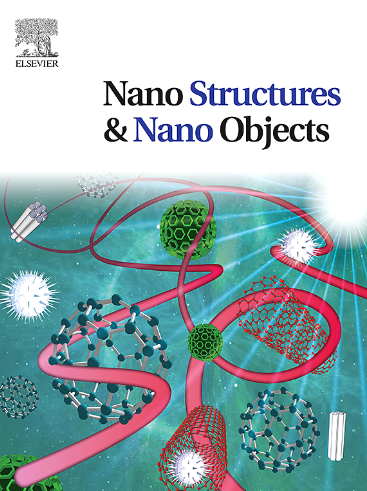改性热注射法制备CsPbBr3/Cs4PbBr6钙钛矿颗粒
IF 5.45
Q1 Physics and Astronomy
引用次数: 0
摘要
三维CsPbBr3钙钛矿纳米晶体(NCs)具有明亮的光致发光强度(PL)和高达90% %的高量子产率(QY)。然而,随着时间的推移,对于这些nc来说,外部因素的影响会导致PL性能的下降。提出了一种改进的热注射法制备CsPbBr3/Cs4PbBr6纳米材料的方法。该方法是基于在两个阶段引入Cs+前驱体。在第一阶段,通过注入Cs+前驱体形成三维nc。在第二阶段,将Cs+前驱体额外引入冷却的反应混合物中以形成0D nc。对相对于三维nc的PL性能稳定性进行了评估。结果表明,对于复合纳米材料,6个月后其发光强度保持不变,为初始发光强度的55 %,而对于三维纳米材料,1个月后胶体溶液的发光强度为10 %。所得的复合纳米材料在480和515 nm波长处表现出两波段的PL。由于所获得的性能,所开发的复合nc可以简化白光LED的生产工艺。本文章由计算机程序翻译,如有差异,请以英文原文为准。
Preparation of CsPbBr3/Cs4PbBr6 perovskite particles by modified hot injection method
Three-dimensional CsPbBr3 perovskite nanocrystals (NCs) have a bright photoluminescence intensity (PL) and a high quantum yield (QY) of up to 90 %. However, over time, for these NCs, the influence of external factors triggers a decrease in PL properties. This paper presents an improved hot injection method for producing CsPbBr3/Cs4PbBr6 NCs. The method is based on the introduction of a Cs+ precursor in two stages. At the first stage, 3D NCs are formed by injecting Cs+ precursor. At the second stage, a Cs+ precursor is additionally introduced into the cooled reaction mixture to form 0D NCs. An assessment of the PL properties stability relative to three-dimensional NCs has been carried out. It is shown that for composite NCs, the PL intensity is maintained after six months and amounted to 55 % of the initial one, while for three-dimensional NCs, a month later, the PL intensity of the colloidal solution was 10 %. The resulting composite NCs demonstrate two-band PL at wavelengths of 480 and 515 nm. Owing to the obtained properties, the developed composite NCs can simplify the technology for white LED production.
求助全文
通过发布文献求助,成功后即可免费获取论文全文。
去求助
来源期刊

Nano-Structures & Nano-Objects
Physics and Astronomy-Condensed Matter Physics
CiteScore
9.20
自引率
0.00%
发文量
60
审稿时长
22 days
期刊介绍:
Nano-Structures & Nano-Objects is a new journal devoted to all aspects of the synthesis and the properties of this new flourishing domain. The journal is devoted to novel architectures at the nano-level with an emphasis on new synthesis and characterization methods. The journal is focused on the objects rather than on their applications. However, the research for new applications of original nano-structures & nano-objects in various fields such as nano-electronics, energy conversion, catalysis, drug delivery and nano-medicine is also welcome. The scope of Nano-Structures & Nano-Objects involves: -Metal and alloy nanoparticles with complex nanostructures such as shape control, core-shell and dumbells -Oxide nanoparticles and nanostructures, with complex oxide/metal, oxide/surface and oxide /organic interfaces -Inorganic semi-conducting nanoparticles (quantum dots) with an emphasis on new phases, structures, shapes and complexity -Nanostructures involving molecular inorganic species such as nanoparticles of coordination compounds, molecular magnets, spin transition nanoparticles etc. or organic nano-objects, in particular for molecular electronics -Nanostructured materials such as nano-MOFs and nano-zeolites -Hetero-junctions between molecules and nano-objects, between different nano-objects & nanostructures or between nano-objects & nanostructures and surfaces -Methods of characterization specific of the nano size or adapted for the nano size such as X-ray and neutron scattering, light scattering, NMR, Raman, Plasmonics, near field microscopies, various TEM and SEM techniques, magnetic studies, etc .
 求助内容:
求助内容: 应助结果提醒方式:
应助结果提醒方式:


